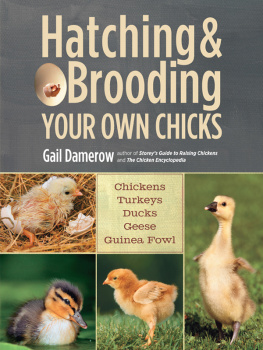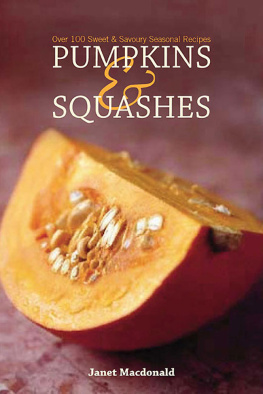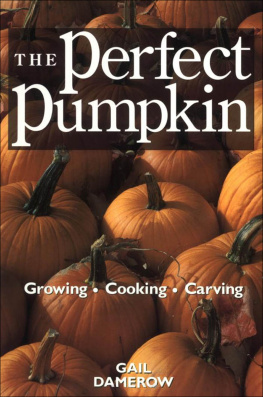Gail Damerow - Grow giant pumpkins
Here you can read online Gail Damerow - Grow giant pumpkins full text of the book (entire story) in english for free. Download pdf and epub, get meaning, cover and reviews about this ebook. year: 1998, publisher: Storey Publishing, LLC, genre: Children. Description of the work, (preface) as well as reviews are available. Best literature library LitArk.com created for fans of good reading and offers a wide selection of genres:
Romance novel
Science fiction
Adventure
Detective
Science
History
Home and family
Prose
Art
Politics
Computer
Non-fiction
Religion
Business
Children
Humor
Choose a favorite category and find really read worthwhile books. Enjoy immersion in the world of imagination, feel the emotions of the characters or learn something new for yourself, make an fascinating discovery.

- Book:Grow giant pumpkins
- Author:
- Publisher:Storey Publishing, LLC
- Genre:
- Year:1998
- Rating:5 / 5
- Favourites:Add to favourites
- Your mark:
- 100
- 1
- 2
- 3
- 4
- 5
Grow giant pumpkins: summary, description and annotation
We offer to read an annotation, description, summary or preface (depends on what the author of the book "Grow giant pumpkins" wrote himself). If you haven't found the necessary information about the book — write in the comments, we will try to find it.
Grow giant pumpkins — read online for free the complete book (whole text) full work
Below is the text of the book, divided by pages. System saving the place of the last page read, allows you to conveniently read the book "Grow giant pumpkins" online for free, without having to search again every time where you left off. Put a bookmark, and you can go to the page where you finished reading at any time.
Font size:
Interval:
Bookmark:
excerpted from The Perfect Pumpkin
by Gail Damerow
Over a million people are estimated to enjoy growing giant pumpkins, the largest member of the vegetable kingdom. Producing big pumpkins is great fun, especially since you can practically see them grow a giant approaching maturity may gain 5 inches (12 cm) of girth and 15 pounds (7 kg) or more in a single day.
Early each October, the annual pumpkin weigh-off isstaged around the world. Gardeners converge on designated sites to heft their giants onto carefully calibrated scales and vie for the world record. Officials call in their sites best weights to their sponsors headquarters, where the winner is determined. If a new record is established, it is submitted to the Guinness Book of World Records. To encourage the growing of exhibition pumpkins by offering prizes to its members, the Great Pumpkin Commonwealth was organized in 1993 as an informal coalition of weigh-off sites throughout the United States and Canada.
Growing giant pumpkins for sport goes back to at least the turn of the 20th century. In 1893 William Warnock of Goderich, Ontario, grew a 365-pound (166 kg) pumpkin which in those days was considered quite a feat. In 1900 Warnock outdid his earlier effort by sending a 400-pounder (182 kg) to the Paris Worlds Fair. In 1903 he again topped his own record with a 403-pound (183 kg) pumpkin exhibited at the St. Louis Worlds Fair. Interestingly, in 1905 Warnock wrote down the basics of growing giant pumpkins, and they remain pretty much unchanged to this day.
The Rennie Seed Company bought a Warnock maxima called Goderich Giantafter Warnocks hometown and sold its seeds for 5 cents each. Howard Dill of Windsor, Nova Scotia, acquired some of the seeds and, through selective breeding, developed the Dills Atlantic Giant the variety that continues to break modern-day records.

Warnocks 1903 record stood until 1976, when Bob Ford of Coatesville, Pennsylvania, entered a 451-pound (205 kg) Dills Atlantic Giantat the U.S. Pumpkin Contest in Churchville, Pennsylvania. Howard Dill beat that record in 1980 with a 459-pounder (208 kg) entered into the Cornell Contest in Pennsylvania. The following year Dill broke his own record with a 493.5-pounder (224 kg).
In 1983 Dill and fellow big-pumpkin enthusiast Ray Waterman of Collins, New York, joined forces to form the World Pumpkin Confederation. At a weigh-off sponsored in 1984 by the fledgling organization, Dills record was broken by Norman Gallagher of Chelan, Washington, who entered a 612-pound (278 kg) specimen. A 671-pound (305 kg) pumpkin grown by Robert Gancarz of Wrightstown, New Jersey, took the record in 1986, and in 1989 Gordon Thomson of Hemmingford, Quebec, won with his 755-pounder (343 kg). Since then a new world record has been established nearly every year.
People laughed when Waterman first mentioned his belief that a 1,000-pound (454 kg) pumpkin would be grown by the end of the 20th century. But when Donald Black of Winthrop, New York, entered an 884-pound (401 kg) pumpkin in 1993, no one was laughing they were all toiling to make Watermans impossibledream become a reality. The following year four growers broke the record, and one of them, Herman Bax of Brockville, Ontario, established a new record just 10 pounds (4.5 kg) short of the elusive 1,000 pounds. Then, in 1996, it happened Nathan and Paula Zehr of Lowville, New York, grew a 1,061-pound (477 kg) pumpkin, and Waterman was vindicated.

Competitive pumpkin growing is big business, with prizes ranging as high as $10,000 and seeds from a record breaker worth as much as $10 each. A world-record pumpkin brings in several thousands of dollars more in display value. No wonder growers of giant pumpkins spend so much time studying soils, fertilizers, plant physiology, and even the effects of music on pumpkin growth.
The obvious question becomes why record-breaking pumpkins all come from northern states, mostly in the Northeast. One answer is that the biggest pumpkins are all the cool-climate-loving maxima. The man who took it upon himself to enhance the growth rate of maximas through genetic selection happened to live in Nova Scotia, so over the years Dills Atlantic Giant pumpkins have naturally become acclimatized to northeastern conditions.
Historian Mary Joan Barrett of Mallorytown, Ontario, gleaned the additional theories from competitive pumpkin growers:
The long hot days and short cool nights of late summer in the northeastern United States and southeastern Canada are ideal for growing pumpkins, which exhibit their most spectacular growth rates from August 1 through September 15.
Phenomenal size has something to do with the effect of growing near a large body of water, perhaps because water acts as a heat sink to create the steady climate pumpkins love.
A tremendous camaraderie has developed among northeastern growers, who share tips and otherwise support one another in their efforts to achieve super results.
But the fun of growing giant pumpkins neednt be confined to northern climates. In 1988 Extension agent George Killgore of Fentress County, Tennessee, launched a giant-pumpkin contest as a way to encourage more fruit and vegetable entries at his countys fair. What started out as just a little fun to spark interest in the local fair has evolved into a countywide pumpkin-growing obsession that culminates with an annual Giant Pumpkin Festival in Allardt, Tennessee, complete with a pumpkin cook-off, along with the official weigh-off.
Sometimes people who see one of the big pumpkins for the first time are disappointed. Its true that these pumpkins are huge, but their shells look pale and washed out compared to the bright orange color youd expect of a proper pumpkin. Worse, the shape is somewhat flattened, as if the old boy had grown tired of the whole thing and was about to give up. Still, in size alone these big fellows are impressive enough.
As you might expect, prima donna pumpkins need plenty of pampering. Contradictory advice abounds, leading to the conclusion that the only road to success is to find the right combination of techniques for your unique growing conditions. Thats what makes the Big One such a challenge.
Among the easiest vegetables to start from seed, pumpkins are a long-season crop, usually requiring 90 to 120 growing days, depending on the variety you plant and the summers temperatures. If your growing season is short, plant one of the early-maturing varieties, or plant seeds indoors and transplant the seedlings after the danger of frost has past. If your growing season is long, you may plant a rapidly maturing variety later in the season, but the vines wont produce as much fruit and will be more susceptible to disease and drought stress than early-grown vines.
Pumpkins are also a warm-season crop. To sprout, the seeds require a soil temperature of no less than 60 F (16 C). The warmer the soil, the faster the seedlings will burst into life. Once sprouted, the tender young seedlings are easily damaged by frost.
The ideal daytime temperature for growing vines is 80 to 85 F (27 to 29 C); the ideal nighttime temperature is 60 to 65 F (16 to 18 C). Vines can tolerate cooler nights, provided the temperature remains above freezing pumpkin vines are extremely frost-tender.
Pumpkins should be planted as soon as the danger of frost is past and the soil is suitably warm. Depending on the part of the country you live in, ideal pumpkin-planting time can range from the beginning of March to the beginning of June. Two rules of thumb:
Font size:
Interval:
Bookmark:
Similar books «Grow giant pumpkins»
Look at similar books to Grow giant pumpkins. We have selected literature similar in name and meaning in the hope of providing readers with more options to find new, interesting, not yet read works.
Discussion, reviews of the book Grow giant pumpkins and just readers' own opinions. Leave your comments, write what you think about the work, its meaning or the main characters. Specify what exactly you liked and what you didn't like, and why you think so.






